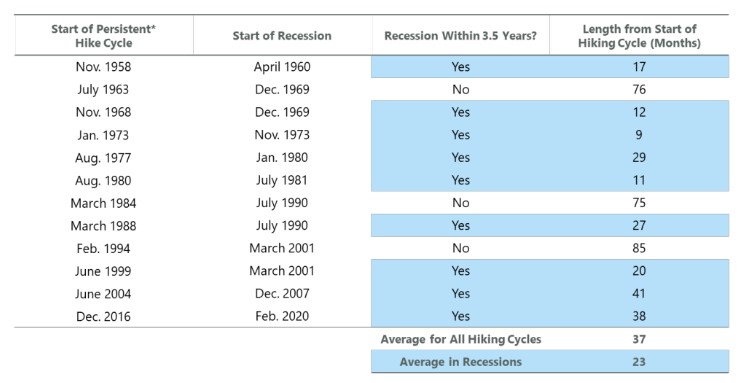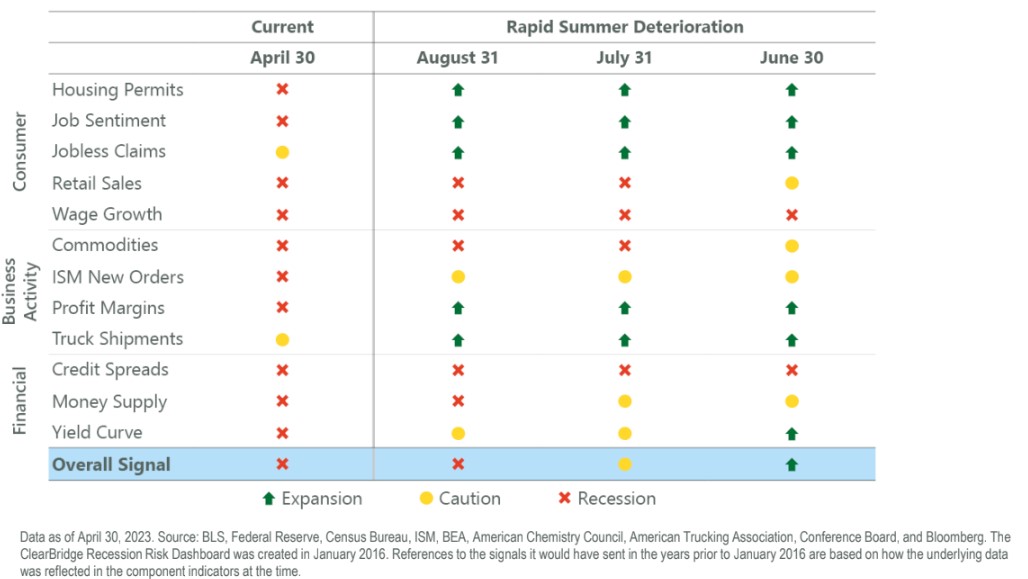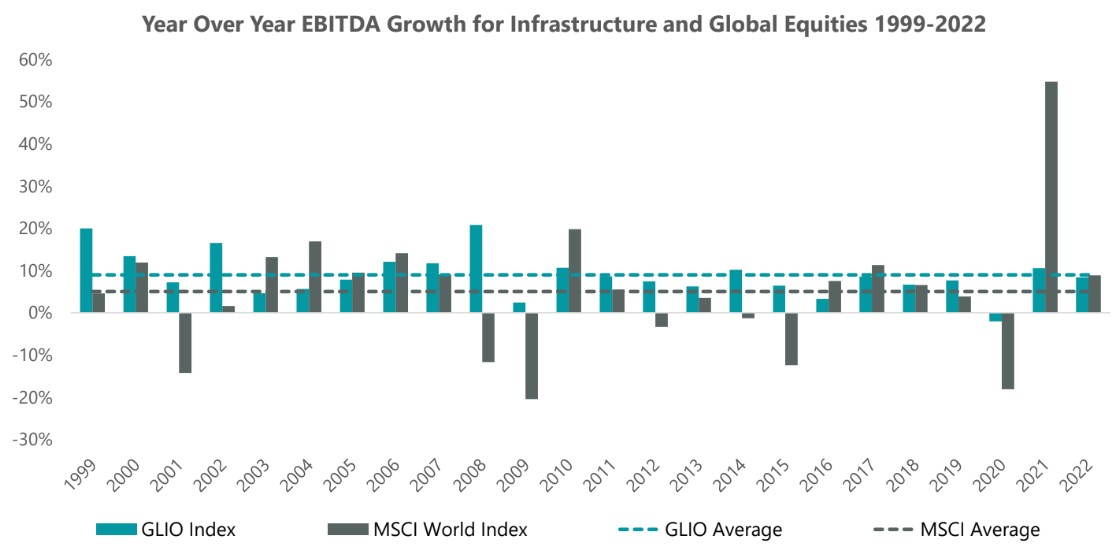How to invest for the most anticipated recession in history
So what should we be expecting and how should investor portfolios be positioned in light of that?
ClearBridge Investments hosted a discussion with Schulze and Nick Langley, Portfolio Management and infrastructure expert, to discuss their take on recession and what investments work in light of that view.
Far from the shallows now
A US recession has become an expectation. That’s with good reason.
Before we even get into economic indicators, history would predict a recession is on its way.
“On average, a recession has begun a little over three years after a rate hike cycle gains momentum. In hard landing scenarios, this timeframe condenses to just under two years,” says Schulze.

Timing for recessions post the start of a tightening cycle. Source: FactSet, ClearBridge
“It’s the first time we’ve seen a recession hit in the third year of a presidential term and this will create some political pressure on the Fed leading into 2024 with political campaigning,” Schulze says.
Schulze’s recession dashboard uses 12 indicators that historically foreshadow a recession across consumer, business activity and financial data. At this stage, only two indicators - jobless claims and truck shipments – aren’t signalling a recession.

Here are some of the reasons why Schulze thinks that’s wrong.
- How ‘tight’ lending standards are set by the US Federal Reserve traditionally influences a downturn. Looser standards are linked to softer landings, while tighter are linked to harder and longer downturns. Currently, standards are tight as a result of recent US bank failures in early 2023.
- Tightening is also disproportionally felt in small banks and in turn, small businesses. This is significant for the US because small banks are responsible for 37% of total lending and 57% of loan growth. By the same token, their clients who are typically small businesses have seen their interest rate repayments move from 5% to 10% in around a year which is a significant cut to profitability. It will also link to job losses as small businesses are forced to cut costs.
- The US Federal Reserve is tipping 1.7 million job losses and is tipped to maintain interest rates above 5% for the rest of 2023. This contrasts with its previous approach, where it would have eased policy ahead of layoff cycles. This possibly suggests a more moderate and longer recession rather than a short and shallow one.
But the good news is that Schulze suggests we’re not looking at a repeat of the GFC. We’re likely to see something more moderate. If he ranks the GFC as being a level 10 on the recession scale, he thinks what is coming is more likely to be a 4-5.
Schulze expects the recession to hit in the third quarter of calendar year 2023.
Investing for the recession we have to have
It’s fair to say investors have heard a lot about being defensive in volatile environments. The old story on careful diversification is one aspect of that, but it’s also worth reiterating the types of sectors and stocks that typically offer better protection in volatile environments.
“Health care and consumer staples are obvious ones. It’s also worth noting that growth outperforms value in a recession,” says Schulze.
“Energy looks cheap now, with the OPEC cut indicating where Saudi Arabia are looking for prices to hit. We may also see a re-rating in tech stocks which were hard-hit last year,” he says.
Infrastructure is another sector investors shouldn’t forget in volatile and recessionary times.
In fact, historic data over 30 years shows that global equities had 7 years with negative growth. By contrast, global infrastructure only had one. This is generally due to the characteristics of infrastructure, with some being essential requirements like water or electricity.

Performance of global infrastructure and equities over 30 years. As of 31 December 2022. Source: Global Listed Infrastructure Organisation (GLIO). Comparison of Year-on-Year EBITDA1 for the GLIO Index (Infrastructure) and MSCI World Index (Global Equities).
Langley points to regulated and contracted utilities as being supportive in environments like this because they have steady demand with prices often inflation-linked such as water and gas companies.
“UK water companies are the gold standard. They have a short-duration investment profile because the regulator adjusts prices on the basis of inflation and interest rates,” Langley says.
On the flip side, you want user-pays assets as you start to move out of a recession because these are assets linked to economic growth, like toll roads and airports.
Transurban (ASX: TCL) is an example of this.
“Transurban’s tolls are based on concession contracts and increase by inflation each quarter, with a 1% minimum growth rate. Usage is linked to business activity so if the economy is growing, Transurban’s revenue typically grows,” says Langley.
Beyond recession – pockets of growth
Langley is also looking for opportunities for growth through a recession and a recovery. A significant one is the "green" transition.
“However you price it, there’s an extraordinary amount of money needed to fund infrastructure needed for the green transition and it will take several decades to fulfil so there’s a lot of opportunity for infrastructure companies on this front,” he says.
Investors may even be surprised to hear that Langley views toll roads as a potential beneficiary. Seriously.
If you look at a future with autonomous electric vehicles, how toll roads are used changes. You don’t need as much space between cars which opens the possibility of more lanes and more cars within those lanes at any given point in time.
Of course, there’s a lot of water to pass under the bridge before we reach that point but the point is that existing infrastructure, like toll roads, can still do well from megatrends like the green transition.
In the meantime though, it’s worth noting that user-pays assets may be more sensitive to a downturn, but will stand to benefit from an eventual recovery – so don’t throw them all out of a portfolio yet.
Is infrastructure part of your defensive allocations in your portfolio? Let us know in the comments below what you use and why.
2 topics
1 stock mentioned

